Establishment and Application of a Novel Four-Dimensional Model for Simulation of a Natural Water Flooding Reservoir—A Case Study of Nanpu No. 2 Structure in the BHW Basin
Abstract
:1. Introduction
2. Geological Characteristics of the Study Area
3. The Novel Idea for 4D Model Research
4. Case Studies and Applications
4.1. Time-Varying Characteristics of Reservoirs at Different Development Stages
4.2. Recovery of the Logging Curve in a Water-Flooded Zone
- (1)
- The permeability of the strong water-flooded layer above the dominant seepage channel was recovered using Equation (1).
- (2)
- The water-flooding degree of the seepage channel side wells should be checked, according to the characteristics of the logging curve and the comprehensive analysis of adjacent wells, to determine whether to conduct recovery or not. Equation (3) denotes the recovery relationship for the permeability of the medium water-flooded layer.
- (3)
- The flooded part in the layer should be recovered, and the non-flooded part should not be recovered, as shown in the No. 33 layer of well NP23-2647 in Figure 5.
- (4)
- Recovery of the top of the positive rhythm channels sand body depends on the water flooding status and degree. The No. 43 layer of well NP23-2646 was presented as a water-flooded layer (Figure 5). However, static and dynamic comprehensive analysis indicated that the top of the well was not flooded due to poor physical properties and low resistivity. Thus, the top of the well was not recovered.

- (1)
- The distribution of reservoir physical properties at different base levels and different locations was considered vertically based on the geological reservoir characteristics. Different quantitative recovery relationships should be established for the different oil groups according to the oil group division results obtained using the logging interpretation model.
- (2)
- A quantitative recovery relationship can be established by classifying different sedimentary microfacies to improve the recovery accuracy if the logging data is abundant.
- (3)
- It is necessary to consider the differences between different dominant seepage channels, distinguish primary and secondary, and strong and weak channels according to their effect on the distribution of the remaining oil in the reservoir, and explore the relationship between well points and locations of dominant seepage channel in the water-flooded layer.
- (4)
- The logging facies, lithology, and rhythm characteristics of the reservoir should be considered, and the water-flooded status of different parts of the same sublayer should be comprehensively evaluated. The difference between the reduction of resistivity curve caused by the thinning of lithology in the middle and upper part of fluvial facies reservoir and the reduction of resistivity after water flooding should also be determined. Details on the composite rhythm logging curve of the superimposed sand body should be highlighted. Different parts of the same sublayer should be considered in sections.
4.3. Initial Construction of the Fine Geological Model
4.4. Numerical Simulations Based on Time-Varying Characteristics of the Reservoir
4.5. Quality Control Based on Monitoring and Dynamic Data
4.6. Characterization of Dominant Seepage Channel and Remaining Oil Distribution
4.7. Application of the Model
5. Conclusions
Author Contributions
Funding
Data Availability Statement
Conflicts of Interest
References
- Sureshjani, M.H.; Ahmadi, M.; Fahimpour, J. Estimating reservoir per-meability distribution from analysis of pressure/rate transient data: A regional approach. J. Pet. Sci. Eng. 2020, 191, 107172. [Google Scholar] [CrossRef]
- Eidsvik, J. Pyrcz and Deutsch: Geostatistical Reservoir Modeling. Math Geosci. 2015, 47, 497–499. [Google Scholar] [CrossRef]
- Zhijun, Z.; Jianglong, X.; Libin, Z. Numerical simulation fitting technology: A case study from Longhupao Oilfield. Lithol. Reserv. 2016, 28, 101–105+134. [Google Scholar]
- Shimi, P.; Zhijun, Y.; Haiyan, L. A New Trial to Build a 4-Dimensional Reservoir Model—A Case Study of the Reservoir Model of Member 3 of the Shahejie Formation in Eastern Hebei Province. Geol. Rev. 2004, 50, 662–666. [Google Scholar]
- Jichun, Z.; Shimi, P.; Lihua, M.; Yijian, S.; Jianmin, L. Four-dimensional dynamic simulation models for flow unit. Acta Pet. Sin. 2005, 26, 69–73. [Google Scholar]
- Ke, Y.; Shao-Chun, Y.; Huai-Qiang, R. Building of 4D reservoir model based on development performance. J. China Univ. Pet. 2010, 34, 12–17. [Google Scholar]
- Xiantai, L. Study on numerical simulation technology based on time varying physicals in mid-high permeability sandstone reservoirs. Pet. Geol. Recovery Effic. 2011, 18, 58–62. [Google Scholar]
- Zhangwen, Y.; Zhongquan, L. 4-D geological modeling of Xing 6 Middle Area reservoir in Xingshugang oilfield of Daqing. Fault-Block Oil Gas Field 2013, 20, 744–747. [Google Scholar]
- Ruizhong, J.; Xin, Q.; Wenchao, T. Numerical Simulation of Reservoir Time—Variation Based on Surface Flux. Spec. Oil Gas Reserv. 2016, 23, 69–72. [Google Scholar]
- Ruizhong, J.; Yongzheng, C.; Yang, H.; Xin, Q.; Yihua, G.; Jianchun, X. Numerical simulation of polymer flooding considering reservoir property time variation. Fault-Block Oil Gas Field 2019, 26, 751–755. [Google Scholar]
- Zene, M.T.A.M.; Jiang, R.; Wei, L.X. Effects of Polymer Injectivity Concentration on Time-Variation Relative Permeability. J. Phys. Chem. Biophys. 2021, 11. [Google Scholar]
- Balogun, Y.; Iyi, D.; Faisal, N.; Oyeneyin, B.; Oluyemi, G.; Mahon, R. Experimental investigation of the effect of temperature on two-phase oil-water relative permeability. J. Pet. Sci. Eng. 2021, 203, 108645. [Google Scholar] [CrossRef]
- Javad, S.; Najafi, A.; Sharifi, M.; Fahimpour, J.; Shabani, M.; Liu, B.; Yan, J.; Ostadhassan, M. An insight into core flooding experiment via NMR imaging and numerical simulation. Fuel 2022, 318, 123589. [Google Scholar]
- Ashman, K.D.; Volpin, S.G.; Kovaleva, O.V. Possible methods for estimating the composition, distribution and properties of residual oil during flooding (Russian). Oil Ind. J. 2019, 2019, 114–117. [Google Scholar]
- Shadadeh, M.; James, L.A.; Johansen, T.E. An improved procedure for generating pseudorelative permeabilities for water flooding in stratified reservoirs. J. Pet. Explor. Prod. Technol. 2018, 9, 449–459. [Google Scholar] [CrossRef] [Green Version]
- Landa-Marbán, D.; Bødtker, G.; Vik, B.F.; Pettersson, P.; Pop, I.S.; Kumar, K.; Radu, F.A. Mathematical modeling, laboratory experiments, and sensitivity analysis of bioplug technology at Darcy scale. SPE J. 2020, 25, 3120–3137. [Google Scholar] [CrossRef]
- Zare, A.; Bagheri, M.; Ebadi, M. Reservoir facies and porosity modeling using seismic data and well logs by geostatistical simulation in an oil field. Carbonates Evaporites 2020, 35, 703–708. [Google Scholar] [CrossRef]
- Rahimi, M.; Riahi, M.A. Static reservoir modeling using geostatistics method: A case study of the Sarvak Formation in an offshore oilfield. Carbonates Evaporites 2020, 35, 25–38. [Google Scholar] [CrossRef]
- Zargar, Z.; Thakur, G.C. Importance of reservoir simulation and early reservoir management for successful field development—Case study. Energy Rep. 2022, 8, 5038–5052. [Google Scholar] [CrossRef]
- Fernandes, B.R.B.; Sepehrnoori, K.; Delshad, M.; Marcondes, F. New fully implicit formulations for the multicomponent surfactant-polymer flooding reservoir simulation. Appl. Math. Model. 2022, 105, 751–799. [Google Scholar] [CrossRef]
- Jiang, R.; Zhang, W.; Zhao, P.; Jiang, Y.; Cai, M.; Tao, Z.; Ming, Z.; Tianlu, N.; Jianchun, X.; Yongzheng, C.; et al. Characterization of the reservoir property time-variation based on ‘surface flux’ and simulator development. Fuel 2018, 234, 924–933. [Google Scholar] [CrossRef]
- Galindez-Ramirez, G.; Contreras, F.R.L.; Carvalho, D.K.E.; Lyra, P.R.M. A very high-order flux reconstruction approach coupled to the MPFA-QL finite volume method for the numerical simulation of oil-water flows in 2D petroleum reservoirs. Appl. Math. Model. 2022, 106, 799–821. [Google Scholar] [CrossRef]
- Wei, Z.; Bin, L.; Xinran, W.; Xilin, L.; Zhiqiang, Z. Research on the evolution of high conductive channels based on formation parameters variation. Xinjiang Oil Gas Field 2019, 15, 61–66+4. [Google Scholar]
- Jamshidnezhad, M. Experimental Design in Petreoleum Reservoir Studies; Petroleum Industry Press: Beijing, China, 2020; pp. 102–146. [Google Scholar]
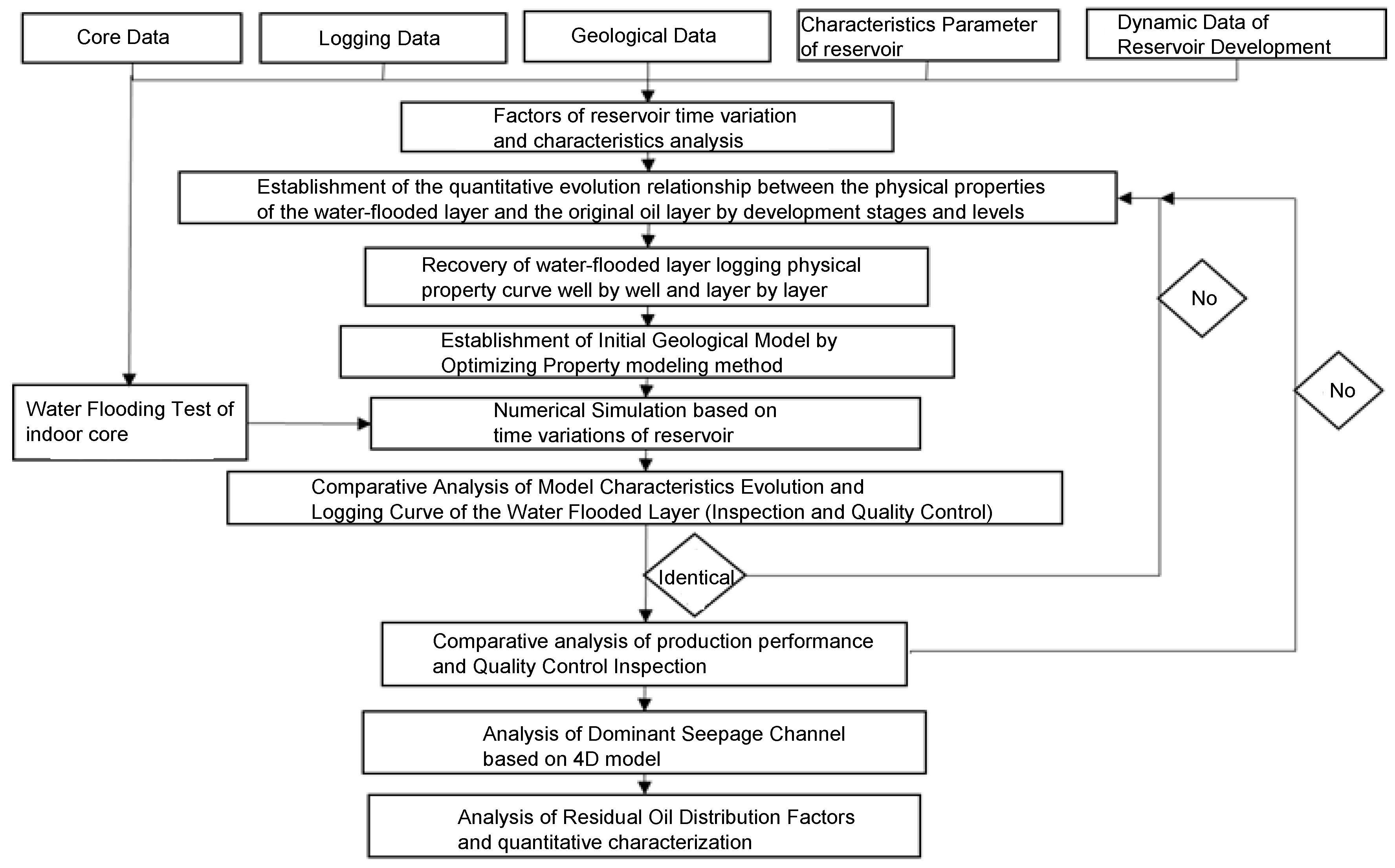
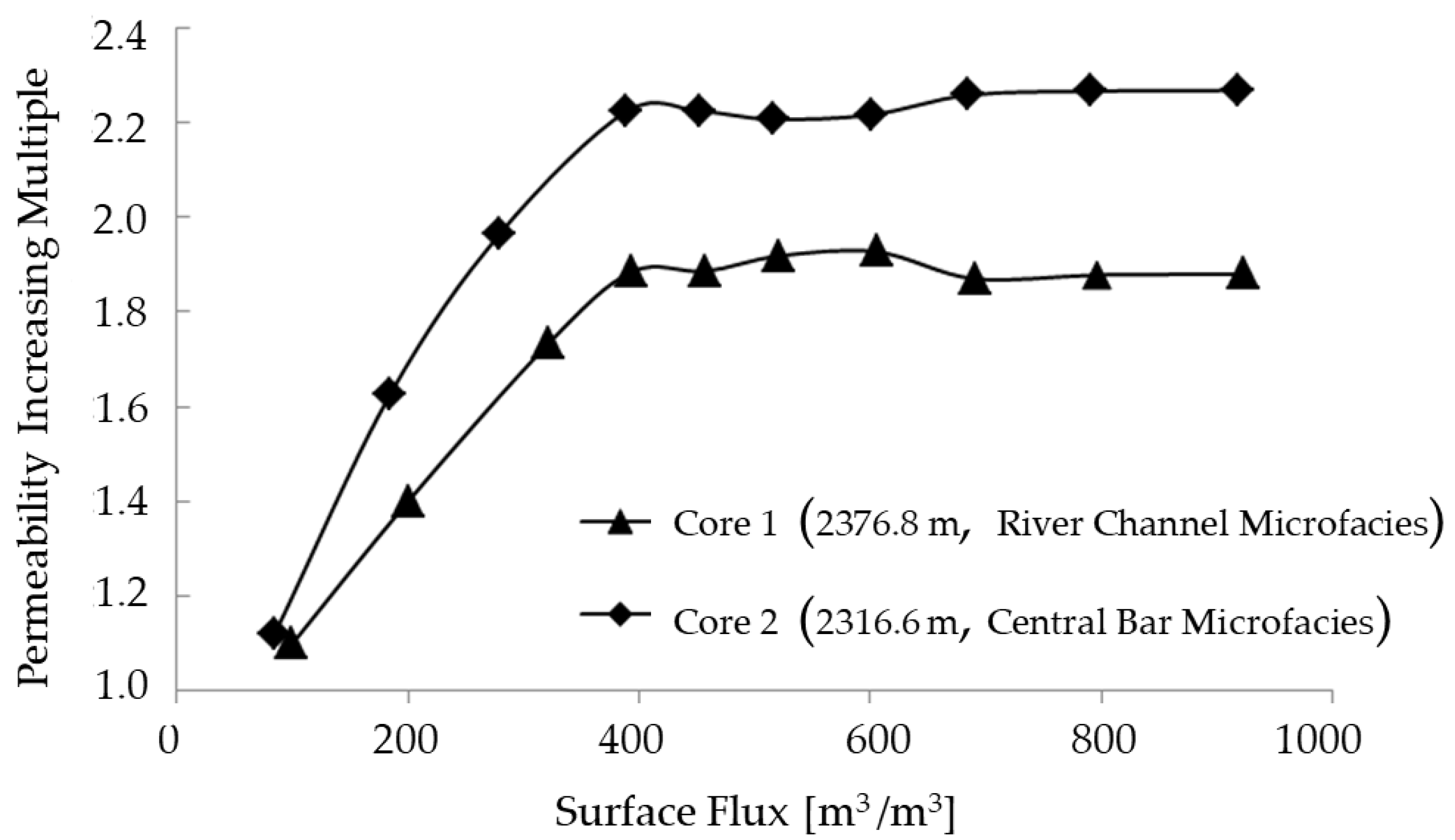


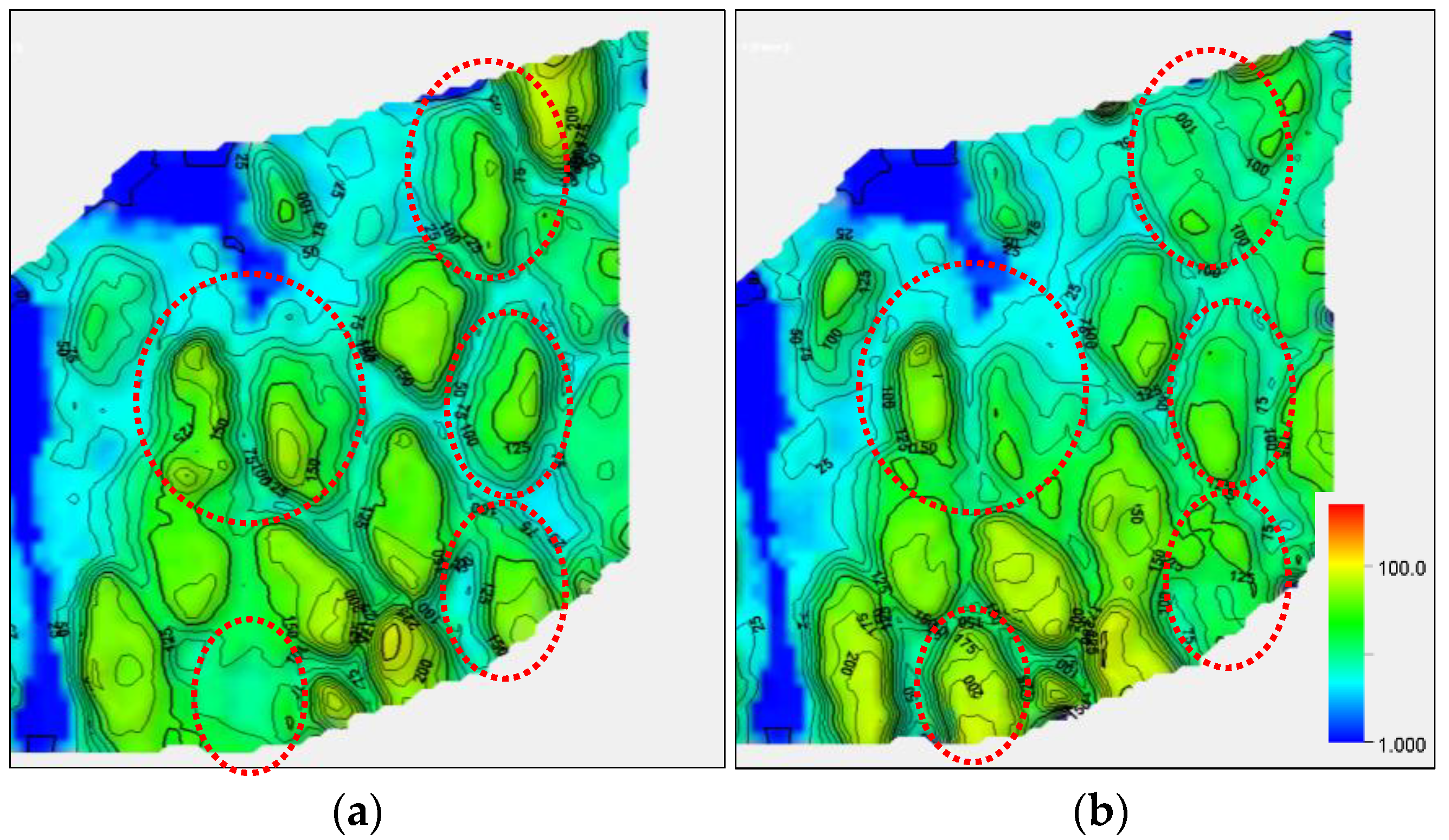


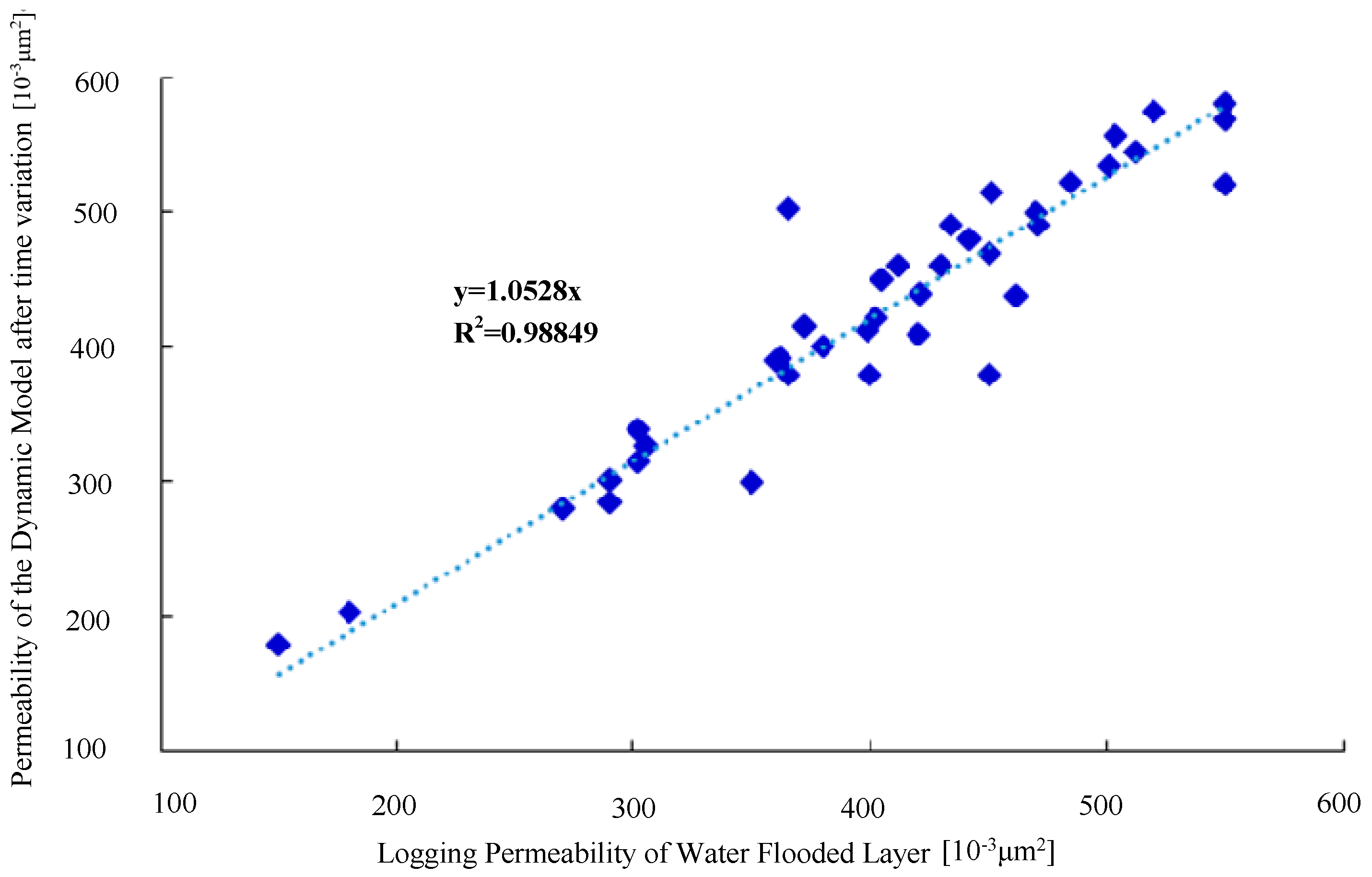


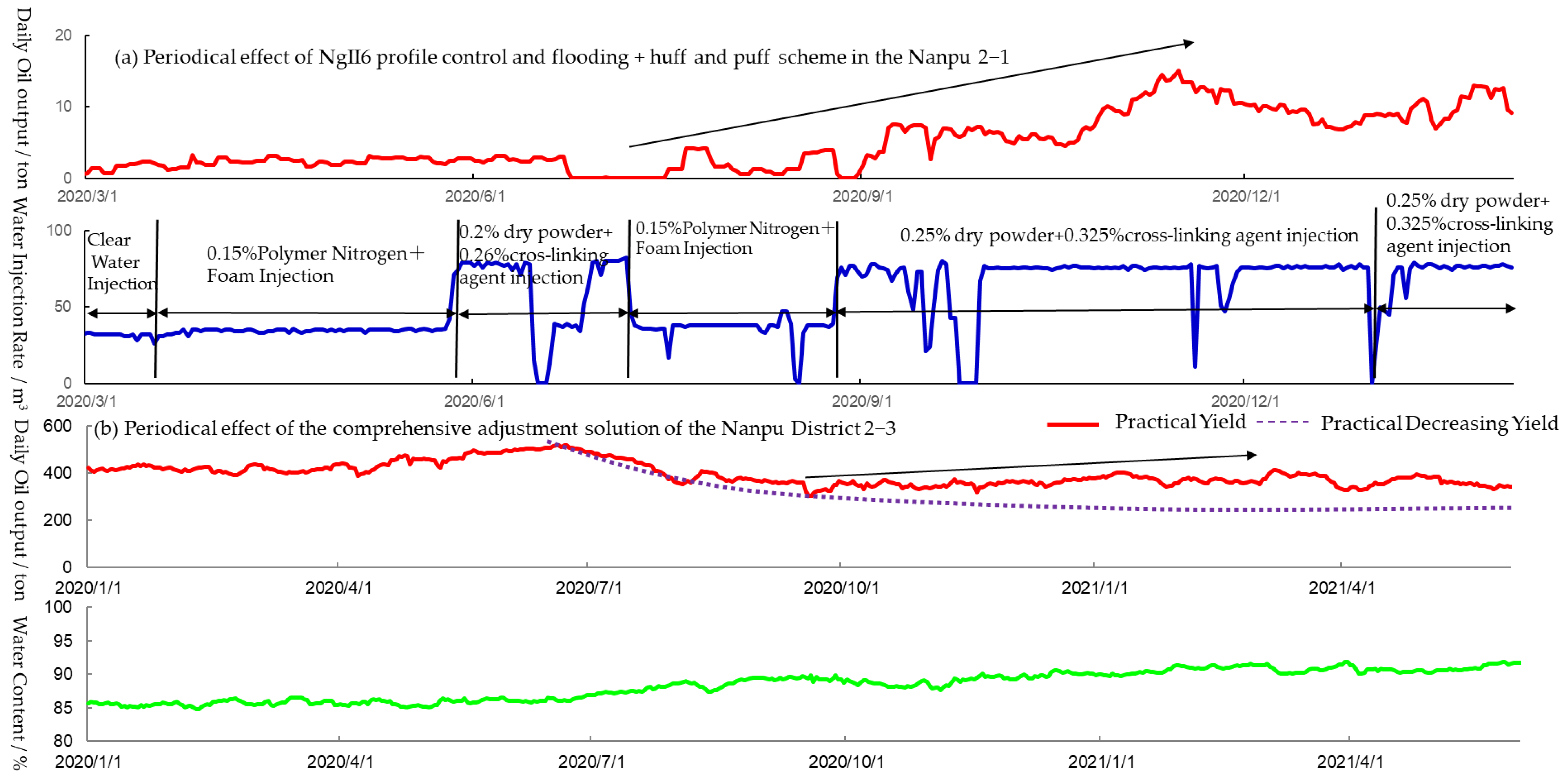
| Sublayer No. | Intrinsic Porosity [%] | Porosity after Water Flooding [%] | Porosity Increasing Multiple | Intrinsic Permeability [×10−3 μm2] | Permeability after Water Flooding [×10−3 μm2] | Permeability Increasing Multiple |
|---|---|---|---|---|---|---|
| II5 | 24.2 | 26.9 | 1.11 | 256.2 | 458.2 | 1.79 |
| II6 | 24.1 | 27.1 | 1.12 | 228.4 | 402.6 | 1.76 |
| II13 | 25.4 | 27.4 | 1.08 | 303.6 | 481.8 | 1.59 |
| III2 | 25.8 | 28.2 | 1.09 | 356.6 | 698.2 | 1.96 |
| Development Stage | Horizontal Position of Water Flooding | Type of Microfacies | Layer Number | Thickness of Sand Oil Layer [m] | Average Thickness of Water Flooding [m] | Logging Analysis | Porosity Recovery | Permeability Recovery |
|---|---|---|---|---|---|---|---|---|
| 2019–2020 | Above the dominant channel | River channel; Central bar; Concave flood plain | 12 | 6.5 | 4.3 | Strong water flooding | Y = 18.5e0.0094X | Y = 132.3e0.0007X |
| 2007–2018 | Above the dominant channel | River channel; Central bar; Concave flood plain | 14 | 7.6 | 4.2 | High water flooding | Y = 16.6e0.014X | Y = 73.9e0.0022X |
| Flanks of the dominant channel | 38 | 6.8 | 4.3 | Medium water flooding | Y = 14.2e0.0201X | Y = 68.9e0.0035X | ||
| 25 | 7.2 | 3.5 | Weak water flooding | - | - |
| Relative Permeability Curve | Surface Flux [m3/m2] | Irreducible Water [%] | Isotonic Point [%] | Residual Oil [%] |
|---|---|---|---|---|
| SCAL0 | 0 | 0.346 | 0.612 | 0.222 |
| SCAL1 | 200 ≤ M < 300 | 0.362 | 0.601 | 0.202 |
| SCAL2 | 300 ≤ M < 400 | 0.373 | 0.592 | 0.190 |
| SCAL3 | 400 ≤ M | 0.381 | 0.586 | 0.178 |
Disclaimer/Publisher’s Note: The statements, opinions and data contained in all publications are solely those of the individual author(s) and contributor(s) and not of MDPI and/or the editor(s). MDPI and/or the editor(s) disclaim responsibility for any injury to people or property resulting from any ideas, methods, instructions or products referred to in the content. |
© 2023 by the authors. Licensee MDPI, Basel, Switzerland. This article is an open access article distributed under the terms and conditions of the Creative Commons Attribution (CC BY) license (https://creativecommons.org/licenses/by/4.0/).
Share and Cite
Duan, J.; Zhu, L.; Luo, W. Establishment and Application of a Novel Four-Dimensional Model for Simulation of a Natural Water Flooding Reservoir—A Case Study of Nanpu No. 2 Structure in the BHW Basin. Processes 2023, 11, 189. https://doi.org/10.3390/pr11010189
Duan J, Zhu L, Luo W. Establishment and Application of a Novel Four-Dimensional Model for Simulation of a Natural Water Flooding Reservoir—A Case Study of Nanpu No. 2 Structure in the BHW Basin. Processes. 2023; 11(1):189. https://doi.org/10.3390/pr11010189
Chicago/Turabian StyleDuan, Jian, Lu Zhu, and Wanjing Luo. 2023. "Establishment and Application of a Novel Four-Dimensional Model for Simulation of a Natural Water Flooding Reservoir—A Case Study of Nanpu No. 2 Structure in the BHW Basin" Processes 11, no. 1: 189. https://doi.org/10.3390/pr11010189





